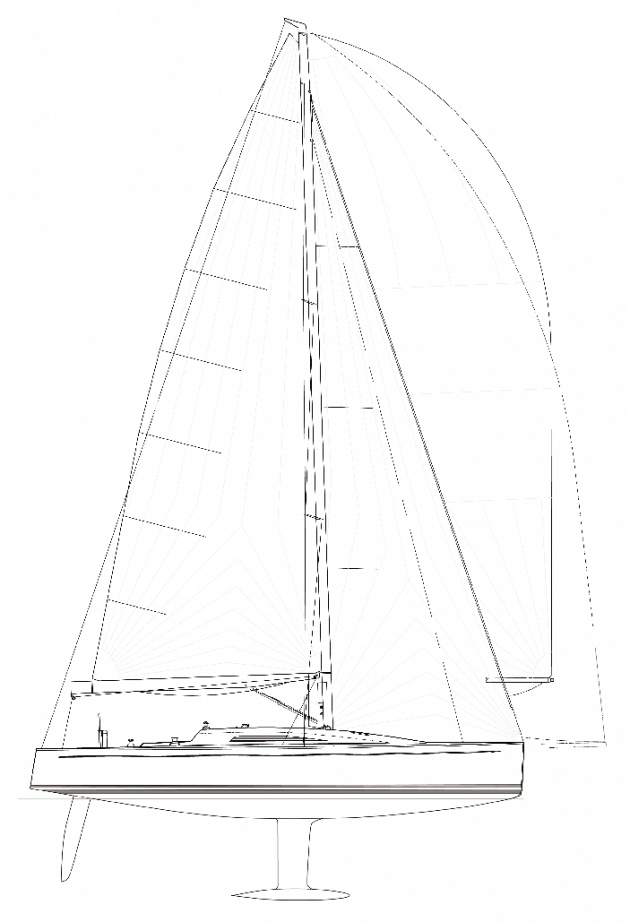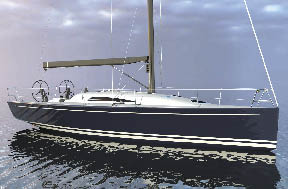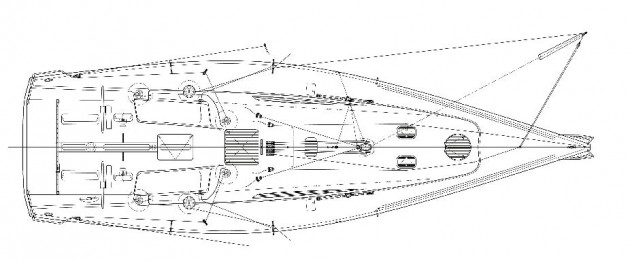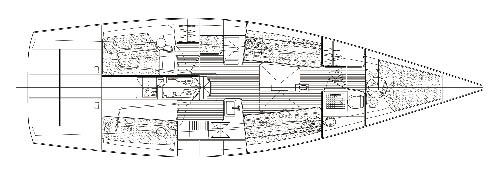King 40
2007 December 5
December 2007
Racer-cruiser
Here's a really handsome design from my old friend Mark Mills. The King 40 will be built by Barry Carroll and George Carabetta at Summit Yachts in Tiverton, Rhode Island. The design is intended to be a racer-cruiser type, and while that is a label we see on a wide variety of boats, I think this design hits the target spot on.
The design is based on two highly successful Mills designs, the IRC 39 Mariners Cove and the IRC 40 Tiamat. Both boats were United Kingdom IRC champions this year. That's a darn good place to start. While we don't see much IRC racing on my coast, the IRC is quite healthy in Europe and especially in the UK, and is catching on on the East Coast. The general IRC type is of medium displacement, for a racing boat, and has plenty of draft and stability. Stability is not penalized under the IRC rule. Draft is, but actual RM, i.e. stability, is not. Putting a lot of lead in a deep bulb can allow the designer to reduce the BWL for light air speed while not sacrificing stability.
The D/L is 160 and the L/B is 3.27. Draft is generous at 8 feet, 2 inches, with the lead ballast hung in a T configuration on a steel fin. There is only a hint of spring to the sheer and about 5 feet of overhang aft. Note the depth of that high-aspect-ratio bladelike rudder. The bow is fine and the stern is broad, and the topsides are very slabish and flat with a tight turn to the bilge that starts well forward. There is no deadrise to the sections at all once you get past Station 3. In some ways I can see the influence of the America's Cup boats in this hull form. Forward, the DWL is very gently hollowed.
Hull construction uses a vacuum-bagged vinylester sandwich method with Corecell linear SAN foam. Biaxial and unidirectional E-glass fabrics are used. A Yanmar 3JH4CE 39-horsepower diesel driving a Gori prop on a saildrive provides auxiliary power. There is a 31-gallon fuel tank. The rudderstock is carbon fiber.
 The King 40 is laid out very conventionally with a double V-berth forward of the head, saloon settee berths, galley to starboard and nav station to port. You can have an enclosed quarter cabin on the port side or this area can be left open. To starboard there are stacked berths aft of the galley. There are no tricks in this layout but just good common sense and comfortable proportions. This is not the type of layout we generally see in race boats today.
The King 40 is laid out very conventionally with a double V-berth forward of the head, saloon settee berths, galley to starboard and nav station to port. You can have an enclosed quarter cabin on the port side or this area can be left open. To starboard there are stacked berths aft of the galley. There are no tricks in this layout but just good common sense and comfortable proportions. This is not the type of layout we generally see in race boats today.
 The tall, fractional rig has double spreaders swept 19 degrees with the chainplates at the rail. If you only use non-overlapping headsails, as does this design, there is no reason to pull the chainplates inboard. It cleans up the deck plan if you can keep the chainplates at the rail in addition to reducing the compressive load on the mast. The mast is a carbon fiber spar from King Composites. No runners are needed with this rig. Rigging is discontinuous rod and the halyards are Vectran. The SA/D is 24.2 using I, J, E and P, but if we use the actual upwind sail area we get an SA/D of 27.21. The headsail has an LP of 104 percent. There is an option for a carbon fiber retractable sprit but the standard boat comes with a carbon spinnaker pole. The King 40 was designed to excel in light to medium air but with the stability provided I would suspect this design could be a winner in any condition.
The tall, fractional rig has double spreaders swept 19 degrees with the chainplates at the rail. If you only use non-overlapping headsails, as does this design, there is no reason to pull the chainplates inboard. It cleans up the deck plan if you can keep the chainplates at the rail in addition to reducing the compressive load on the mast. The mast is a carbon fiber spar from King Composites. No runners are needed with this rig. Rigging is discontinuous rod and the halyards are Vectran. The SA/D is 24.2 using I, J, E and P, but if we use the actual upwind sail area we get an SA/D of 27.21. The headsail has an LP of 104 percent. There is an option for a carbon fiber retractable sprit but the standard boat comes with a carbon spinnaker pole. The King 40 was designed to excel in light to medium air but with the stability provided I would suspect this design could be a winner in any condition.
 The deck is clean and the cockpit is big. The cabintrunk contours are simple and attractive. Forward in the cockpit the seat backs look too low but that will help when racing. The twin wheels add convenience when sitting outboard and the open transom provides a huge "swim platform." The mainsheet leads aft under the deck as do the jib sheet lead controls. The traveler controls are also led under the deck. It's always fun and educational to chat with Barry Carroll.
The deck is clean and the cockpit is big. The cabintrunk contours are simple and attractive. Forward in the cockpit the seat backs look too low but that will help when racing. The twin wheels add convenience when sitting outboard and the open transom provides a huge "swim platform." The mainsheet leads aft under the deck as do the jib sheet lead controls. The traveler controls are also led under the deck. It's always fun and educational to chat with Barry Carroll.
Racer-cruiser

Here's a really handsome design from my old friend Mark Mills. The King 40 will be built by Barry Carroll and George Carabetta at Summit Yachts in Tiverton, Rhode Island. The design is intended to be a racer-cruiser type, and while that is a label we see on a wide variety of boats, I think this design hits the target spot on.
The design is based on two highly successful Mills designs, the IRC 39 Mariners Cove and the IRC 40 Tiamat. Both boats were United Kingdom IRC champions this year. That's a darn good place to start. While we don't see much IRC racing on my coast, the IRC is quite healthy in Europe and especially in the UK, and is catching on on the East Coast. The general IRC type is of medium displacement, for a racing boat, and has plenty of draft and stability. Stability is not penalized under the IRC rule. Draft is, but actual RM, i.e. stability, is not. Putting a lot of lead in a deep bulb can allow the designer to reduce the BWL for light air speed while not sacrificing stability.
The D/L is 160 and the L/B is 3.27. Draft is generous at 8 feet, 2 inches, with the lead ballast hung in a T configuration on a steel fin. There is only a hint of spring to the sheer and about 5 feet of overhang aft. Note the depth of that high-aspect-ratio bladelike rudder. The bow is fine and the stern is broad, and the topsides are very slabish and flat with a tight turn to the bilge that starts well forward. There is no deadrise to the sections at all once you get past Station 3. In some ways I can see the influence of the America's Cup boats in this hull form. Forward, the DWL is very gently hollowed.
Hull construction uses a vacuum-bagged vinylester sandwich method with Corecell linear SAN foam. Biaxial and unidirectional E-glass fabrics are used. A Yanmar 3JH4CE 39-horsepower diesel driving a Gori prop on a saildrive provides auxiliary power. There is a 31-gallon fuel tank. The rudderstock is carbon fiber.
 The King 40 is laid out very conventionally with a double V-berth forward of the head, saloon settee berths, galley to starboard and nav station to port. You can have an enclosed quarter cabin on the port side or this area can be left open. To starboard there are stacked berths aft of the galley. There are no tricks in this layout but just good common sense and comfortable proportions. This is not the type of layout we generally see in race boats today.
The King 40 is laid out very conventionally with a double V-berth forward of the head, saloon settee berths, galley to starboard and nav station to port. You can have an enclosed quarter cabin on the port side or this area can be left open. To starboard there are stacked berths aft of the galley. There are no tricks in this layout but just good common sense and comfortable proportions. This is not the type of layout we generally see in race boats today.  The tall, fractional rig has double spreaders swept 19 degrees with the chainplates at the rail. If you only use non-overlapping headsails, as does this design, there is no reason to pull the chainplates inboard. It cleans up the deck plan if you can keep the chainplates at the rail in addition to reducing the compressive load on the mast. The mast is a carbon fiber spar from King Composites. No runners are needed with this rig. Rigging is discontinuous rod and the halyards are Vectran. The SA/D is 24.2 using I, J, E and P, but if we use the actual upwind sail area we get an SA/D of 27.21. The headsail has an LP of 104 percent. There is an option for a carbon fiber retractable sprit but the standard boat comes with a carbon spinnaker pole. The King 40 was designed to excel in light to medium air but with the stability provided I would suspect this design could be a winner in any condition.
The tall, fractional rig has double spreaders swept 19 degrees with the chainplates at the rail. If you only use non-overlapping headsails, as does this design, there is no reason to pull the chainplates inboard. It cleans up the deck plan if you can keep the chainplates at the rail in addition to reducing the compressive load on the mast. The mast is a carbon fiber spar from King Composites. No runners are needed with this rig. Rigging is discontinuous rod and the halyards are Vectran. The SA/D is 24.2 using I, J, E and P, but if we use the actual upwind sail area we get an SA/D of 27.21. The headsail has an LP of 104 percent. There is an option for a carbon fiber retractable sprit but the standard boat comes with a carbon spinnaker pole. The King 40 was designed to excel in light to medium air but with the stability provided I would suspect this design could be a winner in any condition.  The deck is clean and the cockpit is big. The cabintrunk contours are simple and attractive. Forward in the cockpit the seat backs look too low but that will help when racing. The twin wheels add convenience when sitting outboard and the open transom provides a huge "swim platform." The mainsheet leads aft under the deck as do the jib sheet lead controls. The traveler controls are also led under the deck. It's always fun and educational to chat with Barry Carroll.
The deck is clean and the cockpit is big. The cabintrunk contours are simple and attractive. Forward in the cockpit the seat backs look too low but that will help when racing. The twin wheels add convenience when sitting outboard and the open transom provides a huge "swim platform." The mainsheet leads aft under the deck as do the jib sheet lead controls. The traveler controls are also led under the deck. It's always fun and educational to chat with Barry Carroll.
Comments